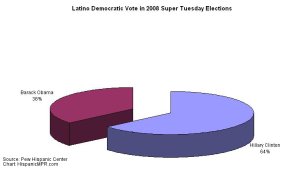How much will Latino Democratic voters influence elections?
Posted by Elena del Valle on March 4, 2008
Latino Democratic Vote in 2008 Super Tuesday Elections – click on image to enlarge
Photo: Pew Hispanic Center
A report based on an analysis of Super Tuesday exit polling data in 16 states about Hispanics from Edison Media Research and Mitofsky International, the firm that conducts exit poll surveys for the National Election Pool, a national consortium of media organizations, indicates Latinos voters could play a deciding role in the selection of a primary Democratic candidate.
Could Latino voters tip the balance in the electoral competition between Hillary Clinton and Barack Obama? Young Latinos seem to be as enthusiastic about Obama as other young people. A string of straight victories for Obama makes the findings of the report ever more important since Clinton’s presidential hopes will rely heavily on the results of the Texas primaries and about one third of Texans are Hispanic.
“Segmentation by Level of Acculturation” audio recording
Presenter Miguel Gomez Winebrenner
Discusses
- Assimilation versus acculturation
- Factors that affect Latino acculturation
- How to know if someone is acculturated
- Number of years necessary for acculturation
- Effects of immigration debate on acculturation
- Three main ways of segmenting Latinos
Click here for details about “Segmentation by Level of Acculturation”
According to the authors of the report, Latinos have already influenced this year’s primaries and caucuses. At the same time Latinos’ share of the Democratic primary vote increased in 12 of the 15 states for which researchers had exit poll data. In the Super Tuesday primaries February 5, 2008 Latinos voted for Clinton (63 percent) almost twice as often as they did for Obama (35 percent).
In California, 30 percent of the voters were Latinos (compared to 16 percent in 2004) and they voted for Clinton by a greater margin than other voters in the state. This year, Hispanic voters have been younger compared to other ethnic groups. More than 20 percent of Hispanic voters on Super Tuesday were 17 to 29 years old, and more than 50 percent of Hispanic voters were younger than 45 years old. Only 33 percent of non Hispanic white voters in the Super Tuesday Democratic primaries were younger than 45.

Mark Hugo Lopez, associate director, Pew Hispanic Center
The report, published by the Pew Hispanic Center and written by Susan Minushkin, deputy director, and Mark Hugo Lopez, associate director, looks at the turnout, demographic characteristics, opinions and voting patterns of Latino voters in relation to the Democratic primaries and caucuses of 2008. Researchers also compared the voting patterns of mainstream, Latino and black voters as well as Latino turnout in 2008 and in 2004.
The Pew researchers aggregated the 16 exit polls and weighted them into a single dataset for each ethnic group voters. There were 1,809 Hispanic, 11,558 white non-Hispanic and 3,120 black non-Hispanic survey respondents. Data from the following 16 states was included: Alabama, Arizona, Arkansas, California, Connecticut, Delaware, Georgia, Illinois, Massachusetts, Missouri, New Jersey, New Mexico, New York, Oklahoma, Tennessee, and Utah.
Prior to working at Pew, Minushkin worked at the Centro de Investigaciones y Docencia Economicas (CIDE) in Mexico City, where she was a professor of international studies and director of an ongoing public and elite survey in Mexico on foreign policy and Mexican attitudes toward international issues. Prior to joining the Pew Hispanic Center, Lopez was research director of the Center for Information and Research on Civic Learning and Engagement (CIRCLE) as well as a research assistant professor at the School of Public Policy at the University of Maryland.
Target Latinos effectively by anticipating changes in the market with
“Hispanic Projections with 2007-08 update” audio recording

Presenter Roger Selbert, Ph.D.
Find out
- About Latino buying power growth in the future
- How Latino market growth compares with other markets in the U.S.
- What drives the rise of Latino economic clout
- Who should target the Latino market
- What is the size of the Hispanic affluent market
- If the luxury Latino market is growing
Stay ahead of your competion with “Hispanic Projections”











